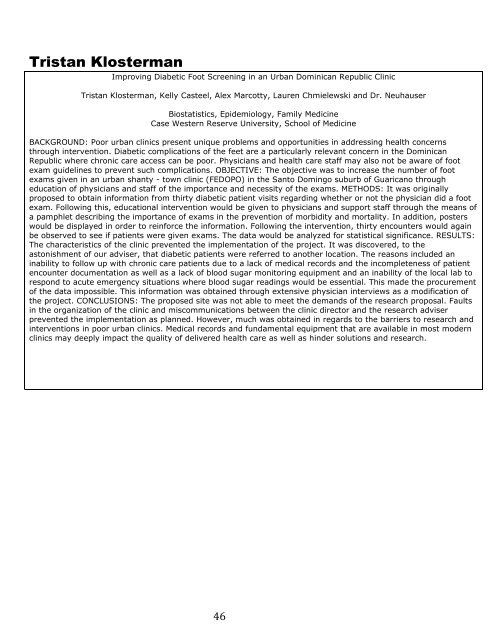student research day - Case Western Reserve University School of ...
student research day - Case Western Reserve University School of ...
student research day - Case Western Reserve University School of ...
You also want an ePaper? Increase the reach of your titles
YUMPU automatically turns print PDFs into web optimized ePapers that Google loves.
Tristan Klosterman<br />
Improving Diabetic Foot Screening in an Urban Dominican Republic Clinic<br />
Tristan Klosterman, Kelly Casteel, Alex Marcotty, Lauren Chmielewski and Dr. Neuhauser<br />
Biostatistics, Epidemiology, Family Medicine<br />
<strong>Case</strong> <strong>Western</strong> <strong>Reserve</strong> <strong>University</strong>, <strong>School</strong> <strong>of</strong> Medicine<br />
BACKGROUND: Poor urban clinics present unique problems and opportunities in addressing health concerns<br />
through intervention. Diabetic complications <strong>of</strong> the feet are a particularly relevant concern in the Dominican<br />
Republic where chronic care access can be poor. Physicians and health care staff may also not be aware <strong>of</strong> foot<br />
exam guidelines to prevent such complications. OBJECTIVE: The objective was to increase the number <strong>of</strong> foot<br />
exams given in an urban shanty - town clinic (FEDOPO) in the Santo Domingo suburb <strong>of</strong> Guaricano through<br />
education <strong>of</strong> physicians and staff <strong>of</strong> the importance and necessity <strong>of</strong> the exams. METHODS: It was originally<br />
proposed to obtain information from thirty diabetic patient visits regarding whether or not the physician did a foot<br />
exam. Following this, educational intervention would be given to physicians and support staff through the means <strong>of</strong><br />
a pamphlet describing the importance <strong>of</strong> exams in the prevention <strong>of</strong> morbidity and mortality. In addition, posters<br />
would be displayed in order to reinforce the information. Following the intervention, thirty encounters would again<br />
be observed to see if patients were given exams. The data would be analyzed for statistical significance. RESULTS:<br />
The characteristics <strong>of</strong> the clinic prevented the implementation <strong>of</strong> the project. It was discovered, to the<br />
astonishment <strong>of</strong> our adviser, that diabetic patients were referred to another location. The reasons included an<br />
inability to follow up with chronic care patients due to a lack <strong>of</strong> medical records and the incompleteness <strong>of</strong> patient<br />
encounter documentation as well as a lack <strong>of</strong> blood sugar monitoring equipment and an inability <strong>of</strong> the local lab to<br />
respond to acute emergency situations where blood sugar readings would be essential. This made the procurement<br />
<strong>of</strong> the data impossible. This information was obtained through extensive physician interviews as a modification <strong>of</strong><br />
the project. CONCLUSIONS: The proposed site was not able to meet the demands <strong>of</strong> the <strong>research</strong> proposal. Faults<br />
in the organization <strong>of</strong> the clinic and miscommunications between the clinic director and the <strong>research</strong> adviser<br />
prevented the implementation as planned. However, much was obtained in regards to the barriers to <strong>research</strong> and<br />
interventions in poor urban clinics. Medical records and fundamental equipment that are available in most modern<br />
clinics may deeply impact the quality <strong>of</strong> delivered health care as well as hinder solutions and <strong>research</strong>.<br />
46
















